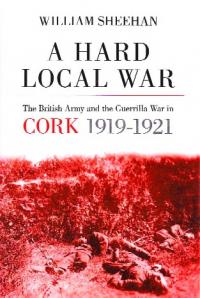A hard local war: the British army and the guerrilla war in Cork, 1919–1921
Published in 20th-century / Contemporary History, Book Reviews, Issue 4 (July/August 2011), Reviews, Revolutionary Period 1912-23, Volume 19
A hard local war: the British army and the guerrilla war in Cork, 1919–1921
William Sheehan
(The History Press, £18)
ISBN 9780752458823
The term ‘revisionist’, now a slur, has been used in recent years to attack historians and their works, and is frequently, although not exclusively, used by non-academics to assail ideas with which they disagree. Jeremy Smith traced the revisionism of War of Independence historiography to the 1940s, when academic historians began to study the war critically. He also noted a backlash against this continuing movement in the 1990s from those taking more nationalist views. More importantly, Smith noted that this struggle was a ‘false dichotomy’, in that both sides were using historical methodology to scrutinise the ‘documentary sources (much of which was not available to previous historians)’ more closely. It is into this ongoing storm that William Sheehan steps with his latest volume—indeed, his first single-author volume and doctoral thesis. Not shying away from the maelstrom, his purpose is to re-examine the conduct and successes of the British army campaign from their perspective.
Sheehan begins with a historiographical essay wherein he decries the field as overly influenced by republican sources and the fact that the resulting popular view is overly pro-nationalist. He notes the dearth of unofficial British sources used and the ensuing absence of British viewpoints. He makes several provocative statements that are heresy to the pro-republican view of the war: that the British army were not losing (or, the IRA were not winning); that reprisals were not simply revenge; that British intelligence was good and improving, as was their propaganda effort; and that there was far greater support for the British than has been admitted. These and other statements are likely to get him pilloried in Irish popular historical settings, but what of his proofs and arguments?
After the introduction the book is arranged into three sections with two chapters each. The first section deals with reprisals and the life of a British soldier in Cork. The second covers British intelligence and law and propaganda. The third section analyses the IRA threat against British transport, the British army’s tactical evolution, the role of RAF close air support, and the shift to an IRA terror campaign before the Truce. After a concluding chapter, the book ends with five appendices of varying utility.
Amongst the new approaches is Sheehan’s methodology in examining reprisals, regarding them as complex local incidents rather than prejudging them as simple atrocities. In the process he brings forward some interesting points, such as reprisals’ coincidence with weekends, paydays, drinking, arguments over local women and violent provocation. Further, he found evidence, counter-intuitively, of considerable conflict between ex-soldiers and serving soldiers. He accordingly recounts incidents of the RIC coming to the rescue of one or the other, and even of republican police doing the same (p. 29).
This work is not without its faults, the first being Sheehan’s use of sources, both secondary and contemporary. While he has used an interesting, wealthy mixture of sources providing a good insight into the British view, he appears to be unfamiliar with the more recent scholarship. Of the 155 works in the bibliography, only 23 date within the past decade, and only eight (five books) deal specifically with Ireland.
The ‘appearance’ is partly due to discrepancies between the bibliography, endnotes and citations. For instance, I naturally noted that one of my quite relevant recent works is mentioned toward the conclusion—but its title is misidentified in the endnotes and does not appear in the bibliography. Indeed, there are quite a few instances of editing errors, notation errors and poor-quality graphics.
Sheehan seems to accept British sources uncritically and, without justification, this will leave him open to attack, since the veracity of some of these is questionable. He also uses many long quotations throughout that are not sufficiently explained or examined; the substance is there but the presentation of it is sometimes lacking. Related to this, there is a surprising lack of specificity in the book. For example, Sheehan spends about ten pages making the important observation that there was distinct evolution in British tactics, but he never actually states what the change in tactics was beyond the use of ‘flying columns’ (pp 136–46).
Sheehan exaggerates some claims, for example when he says that IRA bombs were ‘the greatest and most formidable challenge the IRA posed for the British Army during the campaign’ (pp 125–6). While correct in many respects, this stresses the weapon over its function; weapons were not the purpose of IRA operations, they were merely the tools. Likewise, Sheehan overstates his case when he says that ‘During 1921 the British forces began to take control of the countryside through continual patrolling of their flying columns and aerial patrols’ (p. 156).
This book’s most valuable service is to issue a challenge to historians to re-examine the war and new sources with renewed rigour. It is a fairly comprehensive list of topics on the British campaign, and that is its weakness: it is too short, just 164 pages of text. Sheehan tries to do too much in too short a space. Since there is insufficient textual explanation to develop fully or prove his valuable points, this book becomes an excellent outline of further examination and debate. While this reviewer has been somewhat critical of Sheehan’s study, it is an excellent opening salvo of what hopefully will be a series of studies on these issues from Dr Sheehan. The work is erudite, insightful and most provocative, providing valuable new observations of British views of the conflict. It is a welcome step in the right direction. HI
W.H. Kautt is an associate professor at the US Army staff college, Fort Leavenworth, Kansas.
















